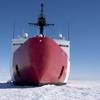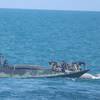China's Navy Enters Strait of Hormuz
Bandar Abbas, home of Iran's navy and the main port in the strategically important Strait of Hormuz, is currently hosting two Chinese naval vessels on a five-day goodwill visit, underlining the increasingly warm relationship between the two countries.
It is the first such port call to Iran by the People's Liberation Army Navy (PLAN) and highlights the efforts both China and Iran are making to counterbalance the power of the United States in the Middle East and along the sea lanes connecting the oil fields of the Gulf with major energy-consuming centres in Asia.
The firepower of the guided missile destroyer Changchun and guided missile frigate Changzhou of the PLAN's 17th escort taskforce is dwarfed by the U.S. Fifth Fleet headquartered in Bahrain. But the port call marks the first time China's navy has entered the waters of the Gulf and the symbolism has not been lost on anyone.
For Iran, the visit is part of a strategy which aims to break out of the isolation being imposed by U.S. and European sanctions by developing closer relationships with China and Russia. In theory, China and Russia remain members of the P5+1 nuclear negotiating team which presents a unified position. In practice, both have clearly indicated their desire to strengthen relations with Iran notwithstanding unresolved issues about the country's nuclear activities.
Iran hopes to exploit the rivalry between the United States on the one hand and China and Russia on the other to secure a more favourable deal in the nuclear negotiations as well as other outstanding issues with the United States and its European and Middle Eastern allies.
For China, on the other hand, the visit is one element in a comprehensive strategy which aims to protect the long and vulnerable sea lanes along which more than 20 percent of its oil consumption comes - from countries in the Middle East across the Indian Ocean and the South China Sea via the Strait of Hormuz and the Strait of Malacca ("Asia's Oil Supply: Risks and Pragmatic Opportunities" May 2014).
SEA LANE STRATEGY
China's naval forces remain comparatively small and mostly suited to operations off the country's eastern and southern coast lines, where their objective is to secure the sea areas out to the first island chain. But in recent years the PLAN has made small deployments into the Indian Ocean, for example anti-piracy activities off the coast of Somalia, as the navy practices longer range operations.
China is still a long way from being able to project enough power to keep the sea lanes across the high seas and through the Strait of Hormuz and the Strait of Malacca open against a determined and capable opponent - which is never named but is understood by all sides to be the United States.
Many Western political and military analysts doubt whether China could acquire the capability seriously to challenge U.S. control of the seas within a meaningful timeframe. The country currently has only one, second-hand aircraft carrier, renamed the Liaoning, compared with the ten carriers operated by the United States.
Western analysts play down the idea of naval competition to control the transit routes between the Middle East and East Asia. But there is no doubt that protecting vital supply and trade routes, as well as countering U.S. influence in Asia and the Middle East, is uppermost in the thinking of China's top military and political leaders.
China's President Xi Jinping has just returned from a tour to Tajikistan, the Maldives, Sri Lanka and India on which he promoted his ideas, first articulated in 2013, about the "Silk Road Economic Belt" and "21st Century Maritime Silk Road".
All four countries on Xi's recent trip are "pivot points" on the "One Belt and One Road", according to People's Daily, the flagship publication of China's Communist Party ("Xi's four-nation tour highlights sincerity of China's neighbourhood policy" Sep 22).
Xi pledged to cooperate with the Maldives and Sri Lanka on "peace, stability and prosperity" as well as "port construction and operation, maritime economy and security, and the construction of a maritime transportation centre in the Indian Ocean" according to People's Daily.
In plainer language, China is seeking to build infrastructure and alliances along the trade routes which connect it to the Middle East.
STRATEGIC COMPETITION
More broadly, China and the United States are engaged in strategic competition for influence and power across the wider Asian region.
In August, General Martin Dempsey, the top U.S. military officer, paid a high-profile visit to Vietnam, the first time a chairman of the U.S. Joint Chiefs of Staff has been to the country since 1971 ("Dempsey building trust in Vietnam visit" Aug 15).
In its official statement, the U.S. Defense Department noted Vietnam's "geostrategic position" between China and Southeast Asia." Vietnam "probably (has) more influence on the South China Sea and how it evolves than any other country," Dempsey said.
The United States has also been strengthening its alliances with Japan, Malaysia and the Philippines to counter Chinese influence, and has spoken out strongly against what it calls China's "destabilising" activities in the South China Sea.
Both rivals are courting India, the biggest prize of all, with the largest military forces, a shared land border with China and dominating the Indian Ocean from its position athwart the major sea lanes.
On his recent trip, Xi promised his Indian hosts more investment in infrastructure and industrial, as well as to increase imports of pharmaceuticals and agricultural products, and talked about a vision of shared prosperity on both sides of the Himalayas.
The PLAN's port call to Bandar Abbas is just one element in an increasingly intense but undeclared competition between the United States and China for regional influence and control of the trade routes in Asia.
The two sides even use the same, carefully coded, language. The commanding officer of China's 17th escort taskforce described the purpose of the port call as "promoting peace and amity, strengthening mutual understanding and mutual trust, and deepening friendly relations," according to the PLA's news service ("Chinese naval taskforce visits Iran" Sep 22).
Dempsey highlighted the importance of "trust" on his own visit to Vietnam and trying to build a relationship on the basis of common interests. The United States would step up its contacts with Vietnam's military, he said, especially on maritime security and law enforcement. "It occurred to me that often adversaries in the past can become our closest friends," Dempsey told his Vietnamese hosts.
For the moment, the balance of forces in Asia and along the transit routes remains overwhelmingly in favour of the United States. But the increasingly fierce if unacknowledged competition between the two powers will be severely destabilizing if it is not managed carefully.
By John Kemp












